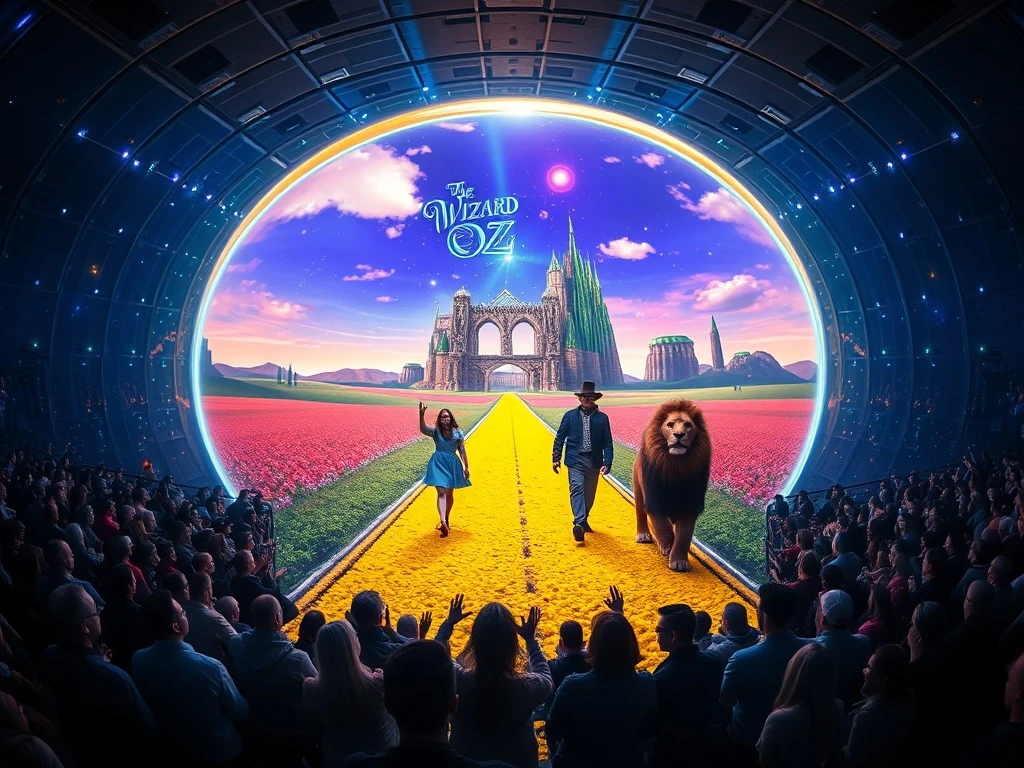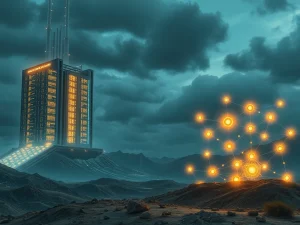Revolutionizing Entertainment: Sphere Las Vegas Unveils AI-Powered Wizard of Oz Spectacle

In an era where digital innovation is constantly pushing boundaries, the convergence of artificial intelligence and immersive entertainment is creating unprecedented possibilities. For those deeply invested in the world of cryptocurrencies and decentralized technologies, understanding these shifts is key, as they often foreshadow new forms of digital assets, metaverse applications, and Web3 experiences. Get ready, because a monumental leap in AI entertainment is about to redefine how we engage with classic media, spearheaded by the architectural marvel that is Sphere Las Vegas.
The Dawn of a New Immersive Experience at Sphere Las Vegas
Imagine stepping directly into the whimsical world of Oz, not just watching it on a screen, but feeling truly present within its iconic landscapes. Sphere Entertainment Co. is making this a reality, announcing a groundbreaking project that transforms the beloved 1939 classic, “The Wizard of Oz,” into an unparalleled 360-degree spectacle. Set to debut on August 28, 2025, this ambitious endeavor leverages cutting-edge AI technologies to bring an entirely new dimension to cinematic viewing at the iconic Sphere Las Vegas venue.
Led by Sphere CEO James Dolan, a dedicated team of 2,000 people has been working to achieve a singular goal: “making viewers feel present during its original shooting.” This isn’t merely a film restoration; it’s a reimagining that aims to blur the lines between observer and participant. The project utilizes sophisticated AI algorithms to:
- Resolution Enhancement: Upscaling the original film stock to pristine, high-definition quality, breathing new life into every frame.
- Outpainting: Extending visual elements beyond the original frame, seamlessly generating new content that expands the scene’s boundaries.
- Frame Expansion: Creating an illusion of stepping into Oz’s world by dynamically expanding and filling in areas that were never part of the original composition.
This innovative approach allows for the addition of intricate details to grainy close-ups and the generation of entirely new visual content, such as an infinitely stretching Yellow Brick Road or expansive, previously unseen distant Oz landscapes. Crucially, this is all done while meticulously preserving the film’s aesthetic integrity and artistic vision.
How Wizard of Oz AI is Redefining Cinematic Immersion
The transformation of “The Wizard of Oz” through Wizard of Oz AI isn’t just about making an old film look better; it’s about fundamentally changing the viewing experience. Turner Classic Movie presenter Ben Mankiewicz highlighted this paradigm shift, noting how AI can transform a “static image into a living world.” This includes generating new character movements and backgrounds, all dynamically tailored to Sphere’s unique 160,000-square-foot LED screen and its remarkable 18,600-seat capacity.
Unlike traditional film restoration, which focuses on cleaning up and preserving the original footage, Sphere’s method aims to “integrate viewers into the film rather than simply modifying it.” This means that the audience doesn’t just watch the story unfold; they become a part of the environment, enveloped by visuals that stretch from floor to ceiling and around them, creating a truly all-encompassing experience. This pioneering effort underscores Sphere’s ambition to set a new benchmark for large-scale digital displays, as Dolan aptly described it, “a statement of what entertainment can become.”
The Technological Marvel Behind the Magic
Sphere’s architectural and technological prowess positions it as a leader in the realm of immersive entertainment. Its colossal wraparound LED display, combined with a sophisticated haptic seating system and advanced audio technology, creates a multi-sensory environment that transcends conventional theaters. This project serves as a powerful demonstration of how cutting-edge technology can unlock new possibilities for legacy content.
The implications for classic film restoration and presentation are profound. By using AI to expand rather than merely clean up archival footage, Sphere showcases how historical content can be adapted to modern platforms without compromising artistic intent. Dolan emphasized that the team’s focus was on “enhancing, not altering” the original work, a delicate balance that is crucial for maintaining the integrity of beloved classics.
This project raises broader questions about the synergy between technological innovation and historical preservation. Analysts suggest that successful execution could redefine industry standards for re-mastering, especially as audiences increasingly demand high-definition, multi-sensory experiences. The project highlights a growing trend: the application of generative AI across various creative industries, bridging the gap between vintage content and contemporary viewing expectations.
Challenges and the Future of Generative AI in Entertainment
While the potential of generative AI in entertainment is vast, the Sphere’s “Wizard of Oz” project also highlights inherent challenges. The delicate balance between leveraging AI for enhanced immersion and overshadowing the original artistic vision is paramount. Ensuring that AI-generated content remains true to the spirit and aesthetic of the original work requires immense skill and artistic sensitivity. The risk of creating a “deepfake” version of a beloved classic, rather than an enhancement, is a fine line to walk.
However, the success of this project could unlock numerous possibilities:
- Reimagining Other Classics: Many other vintage films could benefit from similar AI-driven expansion, offering new life to cinematic treasures.
- Live Event Enhancement: Imagine concerts or sporting events where AI dynamically generates visuals that respond to the action, creating an even more engaging atmosphere.
- Virtual and Augmented Reality: The techniques honed at Sphere could directly inform the development of hyper-realistic VR/AR experiences, allowing users to truly step into digital worlds.
- New Digital Assets: The creation of these enhanced digital experiences could lead to new forms of digital collectibles or exclusive content accessible via NFTs, tying into the crypto ecosystem.
As Sphere prepares for its grand debut of this experience, it signals a pivotal shift in how audiences engage with media. By transforming a 1930s film into a next-generation experience, the venue underscores the immense potential of AI to revolutionize storytelling, seamlessly merging nostalgia with cutting-edge technology. The project’s impact on future entertainment ventures, including virtual and augmented reality applications, remains to be seen, but its immediate significance lies in proving that even decades-old classics can be reborn to captivate new generations.
The Lasting Impact of Immersive Experience Innovation
The Sphere’s pioneering venture with “The Wizard of Oz” is more than just a technological feat; it’s a cultural statement. It demonstrates how innovation can honor the past while boldly forging the future. For those interested in the broader digital landscape, this project serves as a powerful example of how AI, advanced displays, and creative vision can converge to create truly unforgettable moments. As we move further into a world of digital ownership and virtual economies, these kinds of immersive, high-fidelity experiences could become the bedrock upon which future metaverse platforms and digital communities are built.
The success of this project will undoubtedly inspire further exploration into how AI can enhance, rather than replace, human creativity. It’s a testament to the fact that even in our rapidly evolving digital world, the magic of storytelling remains timeless, continually finding new and breathtaking ways to captivate us.
Frequently Asked Questions (FAQs)
Q1: What exactly is AI-driven outpainting and frame expansion?
AI-driven outpainting involves an artificial intelligence system generating new visual content beyond the original frame of an image or video, seamlessly extending the scene. Frame expansion is a similar technique that uses AI to add or infer content to expand the overall visual area, creating a more expansive or immersive view than the original source material provided. Both techniques are crucial for adapting classic films to large, non-standard screens like Sphere’s 360-degree display.
Q2: How does Sphere ensure the artistic integrity of the original film is maintained?
Sphere CEO James Dolan emphasized that the team’s focus was on “enhancing, not altering” the original work. This involves a highly collaborative process where AI algorithms are guided and refined by human artists and film experts. The goal is to expand the visual world of Oz while preserving the film’s iconic aesthetic, character movements, and narrative flow, ensuring the AI-generated content aligns perfectly with the original artistic vision.
Q3: What makes the Sphere Las Vegas venue uniquely suited for this project?
The Sphere Las Vegas is an architectural and technological marvel designed specifically for immersive experiences. Its unique features include a massive 160,000-square-foot wraparound interior LED screen that provides a 360-degree visual experience, advanced haptic seating systems that allow viewers to feel vibrations, and a state-of-the-art audio system that delivers crystal-clear sound to every seat. These combined capabilities allow for a level of immersion impossible in traditional cinemas.
Q4: What are the broader implications of this AI entertainment project for the future of film?
This project sets a new precedent for how legacy content can be re-mastered and presented in the digital age. It demonstrates that AI can be a powerful tool for breathing new life into classic films, making them accessible and engaging for contemporary audiences who expect high-definition, multi-sensory experiences. It could lead to similar AI-enhanced re-releases of other beloved classics, redefine standards for film preservation, and inspire new forms of interactive storytelling in virtual and augmented reality environments.
Q5: Could this technology be applied to other forms of entertainment beyond film?
Absolutely. The AI techniques used for “The Wizard of Oz” could revolutionize live concerts, sporting events, theatrical productions, and even educational content. Imagine a concert where the stage visuals dynamically respond to the music and performers, or a historical documentary where AI expands archival footage to create fully immersive environments. The potential applications are vast, opening new avenues for creativity and audience engagement across the entire entertainment spectrum.









